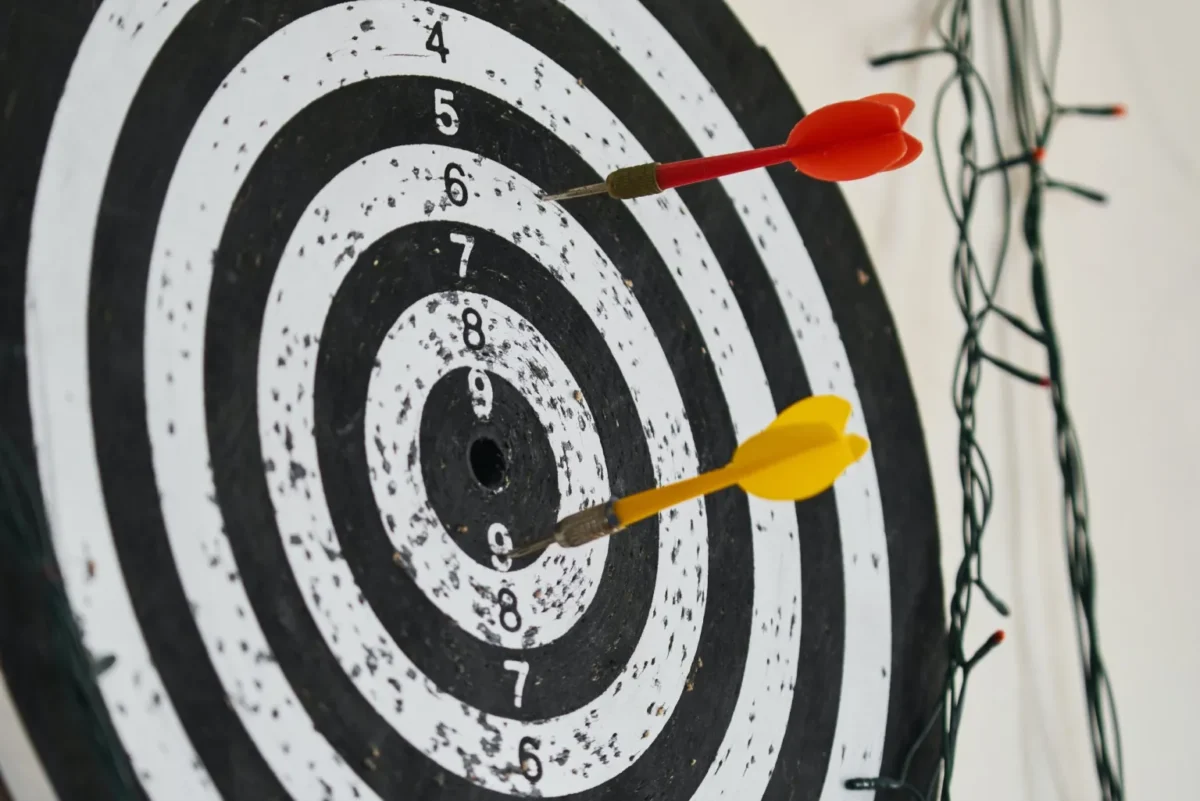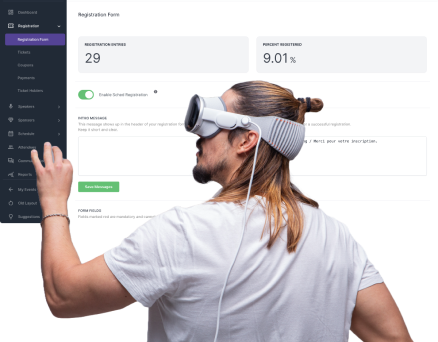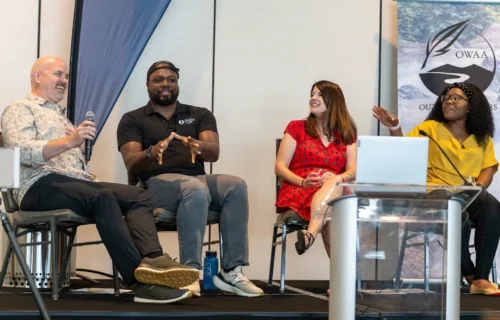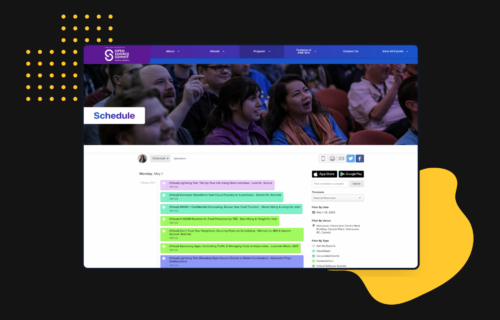Event planning is rarely simple. However, if you have the right goals and objectives, it gets easier. The challenge is how to set relevant goals and objectives for your specific event, which may be harder than it sounds. That’s particularly true when it comes to setting relevant goals for a K-12 event.
What do you want your event to achieve? Whether you’re planning an alumni celebration, a continuing education conference, a curriculum tradeshow, or a workshop, setting clear goals essential. Goals guide your event forward and keep it between the rails. Imagine a classroom without learning objectives—chaotic, right?
Goals also help you measure if it was successful and whether you managed to deliver value to your attendees. How do you set the right goals? What should you be considering?
In this guide, we’ll walk you through everything you need to know to start setting actionable goals for your K-12 events.
TL;DR
Table of contents
- Event goals are the reason you’re organizing the event in the first place. They should guide every decision you make.
- Clear objectives help with focused planning, measurable success, and efficient resource allocation.
- Several different tools and methods can help you set clear, actionable, achievable event goals and objectives, such as the 5-W method or the BQS format.
What Are Event Goals?
Event goals are the heart of your planning process. They speak to the purpose of the event, whether it’s an alumni-focused fundraiser, a literacy night, or a teacher professional development session. Really, goals are all about guidance, and your objectives must be clear if you want that direction.
The Importance of Clear Event Goals and Objectives
When it comes to event objectives, clarity is the primary rule. But how do you ensure that they are? Here’s the breakdown.
Intentional Decision-Making
Without goals, planning is a guessing game. However, with goals in place, each choice becomes intentional from venue selection to speaker invitations. For instance, you want to impress potential donors. The right venue and speakers align with that goal. It really is all about intentionality and focus.
When you align your decisions with your goals, you’ll find that you reach them more easily. It’s so much easier to create and deliver events that move the needle when you know where that needle needs to go. So, to set clear goals for event planners, you need to plan intentionally.
Measurable Success
How do you measure success? Goals provide the benchmark necessary. Whether you need to measure engagement, conversion, or learning success, the right goals help you determine whether your event was effective or not. Here are some event objectives examples:
Did you aim to engage educators? Count the number who attend your event.
Did you intend to help teachers earn the credits necessary for CE requirements? Count the number who passed the test at the end of the event versus the number who attended.
Measurable event planning goals show what worked and where you can improve. Then you can plan your next event with that information in mind and enjoy even better outcomes. So, clear goals aren’t just important for this event; they’re important for all those that come after.
Resource Allocation
Efficient planning means allocating resources wisely. Clear goals help you prioritize what resources go where. If educating teachers is your goal, invest in quality workshops and expert presenters. How do you allocate resources to align with event goals?
First, define the event’s purpose (teacher education, education professional networking, fundraising, etc.).
Next, break those goals into smaller tasks. Let’s say you’re trying to raise funds. “Raising funds” is a pretty big objective and if that’s your only goal, it will be overwhelming.
What are the smaller tasks that help you reach those larger event objectives and what resources do you need to do so? Some examples might include:
Developing a Fundraising Strategy
Suppose you’re developing a fundraising strategy. Here, you’d need to set fundraising goals, identify target donors and funding sources, choose the type(s) of fundraising activities you’ll use, and create both a timeline and budget.
To achieve those tasks, you’ll use resources like strategic planning sessions, market research tools, budgeting software, and access to fundraising consultants or experienced team members.
Donor Research and Cultivation
Looking to tap into donors to help boost funding? You’ll need to research potential donors, build and maintain relationships with them, and tailor your communications to different donor segments.
To achieve those tasks, you’ll need resources like donor databases, a CRM for managing relationships, research tools for prospecting, and the time and staff to handle relationship building.
Team Alignment
Shared goals unite your planning team so that everyone understands the “why,” which usually means better collaboration. This really comes down to defining the purpose of the event and then tying it to something concrete that matters to your organization and your wider audience.
You can use several tools to help improve team alignment and define your “why”, including creating an event planning mission statement.
Let’s say that you’re planning a teacher education event. Your mission statement might look like this:
“Our mission is to help educators develop professionally while inspiring them and helping them understand new tools available to create improved learning environments for students.”
You list many of your most important event goals right there in the mission statement. Plus, you highlight why your event purpose matters to your audience (teachers) and how it impacts the audience’s environment (student environments).
How to Set High-Impact Event Goals: A Step-by-Step Guide
Ready to set event goals that help you deliver what your audience wants and ties into your organization’s mission? We’ve got the lowdown for you. Use the steps below to flesh out your event planning goals, connect your event marketing objectives, and define the overriding purpose of the event.
Use the 5-W Framework
Want to nail your event goals? Then you need to understand your event in every detail. You can use the 5-W framework for that. Essentially, this breaks down the five W’s involved in any event – who, what, when, where, and why – and helps you extrapolate from those points.
- W1: First, there’s the who. Who’s involved in the event? Obviously, there’s your team and your stakeholders, but don’t forget about your audience.
- W2: Second, there’s the what. What are the elements involved in your event? What do you want the audience to learn or take away? What’s the event type? What value do you want to give to stakeholders?
- W3: Third, there’s the when. When will you host the event? How will that impact things ranging from attendee impact to event marketing?
- W4: Fourth, there’s the where. Where will you hold the event? How does the venue impact other aspects of event goal setting and planning?
- W5: Finally, there’s your why. What’s the purpose of the event? Professional development? Fundraising? Awareness? With the five W’s defined, you can move on to the next step, which involves mapping things to your larger goals.
Map to Larger Goals
Align all of your event objectives with the organization’s mission. Make the connection explicit. Look to our mission statement example in the previous section for guidance here. By mapping event goals to your overall mission, you help make the purpose of the event clearer and more concrete.
Prioritize
All goals are not created equal. Focus on what matters most. Is it student learning outcomes? Community building? Teacher education and professional development? Prioritize your goals accordingly so that you can focus on what matters most first.
Use the BQS Framework
On a tight timeline for event goal setting? The BQS framework can help. The sequence of steps ties in with what the acronym stands for, which is:
1. Think Big (B): What are your targets? Set bold ones.
2. Set Small Chunks (S): Take your big targets and break them into small steps/milestones. 3. Move Quickly: Set tight deadlines and make sure your team’s committed to them.
Make Them SMART Goals
The SMART acronym is used throughout all industries to help set goals that can be reached and that have an impact. It stands for Specific, Measurable, Achievable, Relevant, and Time-bound. Here’s what each means when it comes to defining the purpose of your event and a few SMART goals for event planners examples:
- Specific: Define specific outcomes (help 150 teachers meet their CE requirements).
- Measurable: Set defined targets (collect feedback from 100 teachers).
- Achievable: Be realistic about your goals.
- Relevant: Ensure your goals align with your mission.
- Time-bound: Set deadlines (launch the training program by next month).
Event Objectives Examples: Sample Goals for K-12 Planners
What are some relevant goals for event planners examples? We’ve listed a few below, but you can probably come up with plenty of others:
Two goals that help you establish your organization as a thought leader are:
- Become the go-to resource for teachers on innovative teaching methods.
- Share best practices and inspire fellow educators.
A couple of goals related to improving active attendee participation are:
- Keep educators engaged during professional development events.
- Encourage dialogue and collaboration.
Goals that tie into helping you build brand awareness include:
- Showcase your school’s unique programs to prospective families, as well as alums.
- Highlight your STEM initiatives or arts programs.
Start Creating Better Events with Relevant Event Goals
By this point, you should have a better grasp of what event goals are, how they affect your event planning, and how to set relevant goals that truly have an impact on your event’s success.
Remember, setting goals isn’t just about logistics—it’s about impact. Well-defined goals create meaningful experiences for teachers, stakeholders, and everyone else.
FAQs
Can you have multiple event goals and objectives for your virtual event?
Yes, you can have multiple event goals/objectives. However, make sure your goals and objectives support the overall mission and fit your audience’s needs. Having multiple goals and objectives can help you cater to different stakeholders, create events that are more impactful to your wider audience, and more. With that said, make sure that your goals and objectives don’t conflict and that they follow the SMART framework.
What is an event planning mission statement?
An event planning mission statement describes the purpose of your event, why it matters, who it supports, and why you’re planning it. A well-crafted event planning mission is a guide for event planners and staffers and helps you set accurate goals and objectives.
Your event planning mission statement can be short or long, but it must communicate three things: the event’s purpose, its goals, and its values. When planning, try to include your organization’s specific tone of voice, a message tailored for your audience, and what makes your event unique.
What are some bad examples of event goals?
Bad examples of event goals are vague, lack a timeline, are irrelevant, or even overly ambitious. For instance, “Make the event successful” is too vague, “Increase attendance by 500%” is unrealistic, “Raise $10,000” isn’t time-bound, “Attract as many attendees as possible” is unclear, “Ensure attendees learn a lot” isn’t specific enough, and “Make the event go viral” is not specific enough.
What are event marketing goals?
Event marketing goals are specific objectives you use to guide the planning, promotion, and delivery of events. It’s all about increasing awareness of your event, reaching your target audience, creating a sense of curiosity or need, and then encouraging your audience to act. For instance, it might be to get them to sign up for and then attend the event.
What are the long-term goals for event planners?
Long-term goals for event planners help ensure the events they plan are effective, sustainable, and impactful. Those goals can tie into individual events, but they also tend to connect with the planner’s personal brand. It’s about creating an identity for the planner’s events, boosting event quality and impact, and creating events that truly benefit audience members and other stakeholders.









